I am absolutely charmed and captivated by the Mystical Tarot, a deck by Giuliana Costa and published by Lo Scarabeo in 2017. The artwork is going to be reminiscent of the art style in the classic Sola Busca Tarot, timeless, painstakingly detailed for maximum sign and symbolism intuitive work, and just all around an incredible deck to work with. It lends itself perfectly to a professional tarot reader’s go-to “workhorse deck,” and essentially reads like a Rider-Waite-Smith.
The artwork is magnificent to behold. At the bottom of the Majors, as you can see in the photograph above, are glyph references for the astrological correspondences. The world that these characters in the cards inhabit is both familiar as our world but…also not. It seems to be an other-world as well. The above glimpse of Key IX starts to give a hint as to what I’m talking about (look up in the sky), but as we progress along, you’ll see exactly what I mean.
Deck packaging is minimalist and fine. It comes in a top flap box and includes a standard little white booklet (LWB). The LWB is not bad. It’s got succinct and yet rather easy to work with card meanings.
I don’t love the card back design, however. It’s not exactly reversible, as you can see in the center diamond, but could be if you want it to, since in a reading, unless you’re going out of your way trying to pay attention, you wouldn’t be able to detect the reversals from the rest of the design, which is symmetrical. It resembles two horns and then…man, I gotta tell you…to me, the untrained eye, it looks four shrimp. I’m not a big fan of the shrimp depiction on the card back design. Maybe there’s a flaming serpent vibe that was intended here, but I just see four shrimp with long ass curly-cue tails staring angrily at each other. It’s really not my favorite card back design. A touch disappointed with that, but then everything else is up from here! Wow is this a spectacular deck!
There’s that Luminist art style characteristic of the 19th century hinted at here, which also feels deeply European-Romantic in influence. There are so many layers of symbolism you can work with in these cards that I’m a bundle of excitement right now.
The banana by the foot of The Fool with two black cats in the background up in the tree looking on adds a portentous prevision to the Fool’s journey. I love the combination of alchemical symbols, tools, and the Egyptian cats forming the Magician’s table. The yin-yang symbol in the High Priestess evokes in me a sense of magic, though for many, could very well evoke the sense of harmony and balance that’s typically reflected in the numerology of Key 2. Look closely at the jars atop the High Priestess’s throne. By the way, all the images in this blog post are linked, so you can click on them to enlarge and check out the detailing. I’m intrigued by how the Emperor is facing the Empress…
I love the depiction of Key 13: Death here, and the depiction of the Devil is provocative to say the least. Key 19: The Sun calls to mind the many-faced god or goddess archetype found in many of the polytheistic pantheons of the East, not to mention the golden chariot mythology often associated with the sun that you see depicted here on Key 19.
In Temperance, look at the illustration of the reflection in the water. It’s just incredible. The artwork here is at the top tier of mastery, as good as they come for the purposes of the tarot architecture.
I’ll present the Minors in the order they came in straight out of the packaging–Cups, Pentacles (or Coins), Wands, and then Swords. I associate the dragon with the element Water, and here formed among the clouds in the Ace of Cups is a dragon. The Mystical Tarot is less Kabbalistic in focus than most esoteric tarot decks, by the way, so for instance, depictions of leaves from the Tree of Life are notably missing in many of the cards that typically feature them, the arrangement of coins in the Ten of Pentacles below is not in the formation of the Tree, and so on. Here, I also like how the depiction of characters in the Two of Cups is gender neutral in the ways you can read or impart your perspective onto that card.
The urban landscape behind the Four of Pentacles is both familiar and timeless enough for us to associate with any landscape from our world, and yet it’s also unfamiliar enough to convey an other-worldliness. That surreal impression becomes even more apparent in the backdrop of the Ten of Pentacles.
I love that Nine of Wands. For me, what’s fascinating just in terms of a statement of perception is how symbolically, it’s identical to the Nine of Wands in the Rider-Waite-Smith, touching on all the key symbols and placements, and yet the final vibe I get from this Nine of Wands is oddly different from the RWS Nine of Wands. I feel like this Nine of Wands in the Mystical Tarot is stronger, more resilient, dealing far better with her battle wounds than the guy in the RWS Nine of Wands, and the shadow cast by the figure here and the figure in the Ten of Wands is interesting–there’s consistent directionality here in terms of the presumption of where the sun is, if you know what I mean. Just look at the Nine and Ten of Wands in a series.
A white crane or white heron for me has always been a symbol of knowledge and here we see that symbolism on the Ace of Swords. In the Three of Swords, the three daggers now pierce into the head rather than the heart, which for me is going to change the way I interpret the Three of Swords when it comes up in a reading. I also love the symbolism of the three moths here. In the Four of Swords, instead of the fourth sword embedded into the coffin, here in the Mystical Tarot, it’s suspended above the soldier. Depicted in the stained glass is an angel and a soldier kneeling in veneration in front of that angel.
Now in the Five of Swords, we start to wonder what world exactly we’re on. If you look in the sky, from my vantage point, I see a planet. Then both the Six of Swords and Ten of Swords hint at an other-worldliness. Love the owl perched in the background of the Ten of Swords.
One way I operate the tarot deck in divination is to tune in to specific symbols in a card and follow a narrative that extends well beyond the imagery on that card as it unfolds from just one specific symbol. The Mystical Tarot is perfect for such a reading technique.
Also, notice how among the courts in the suit of Swords here, you see the clouds form a water bearer for Aquarius in the Page of Swords, the balancing scale in the Knight of Swords for Libra, and the twin faces for Gemini in the Queen of Swords…
The intentions that I believe have been etched into this deck, whether consciously by the artist or unconsciously, renders this deck distinctly magical. There’s a possibility of astral travel that I see in the Six of Swords.
You’ll really want to pull out a magnifying glass to study these cards intensely. Notice the constellation in the background of the Two of Swords.
The specific arrangement of swords in the Eight of Swords intrigues me. Also, the bandage around the woman’s eyes gives me pause. Is she wounded and bleeding from her right eye? Can she perhaps see through her blindfold and isn’t as ignorant as we may presume? Here in the Eight of Swords the imagery diverges significantly from the typical RWS system, which can throw some RWS readers off in the typical ways the Eight of Swords is read.
I found the deck to read remarkably well. It’s a great professional working deck, if you’ve been looking for one. I find that for professional working decks, I prefer ones that don’t have card titles (even though for beginner decks, I prefer the ones that have card titles). I also prefer decks that are “busy” with symbolism like the Mystical Tarot. And the artwork here–you won’t be able to get me to shut up about how beautiful the art is on this deck.
The Mystical Tarot speaks to me and expresses the collective unconscious in a way that feels universal, timeless, and infinite. Taken in totality, this deck is a psychic playground. I love it.



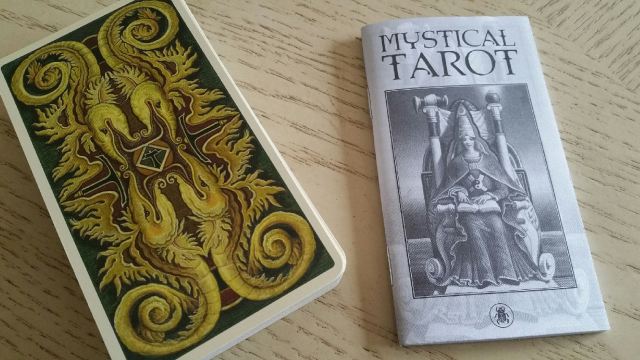

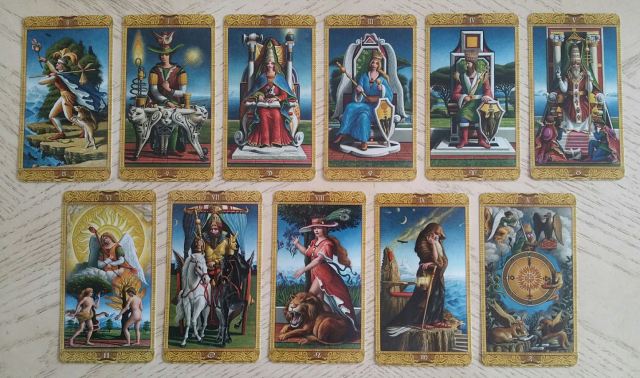
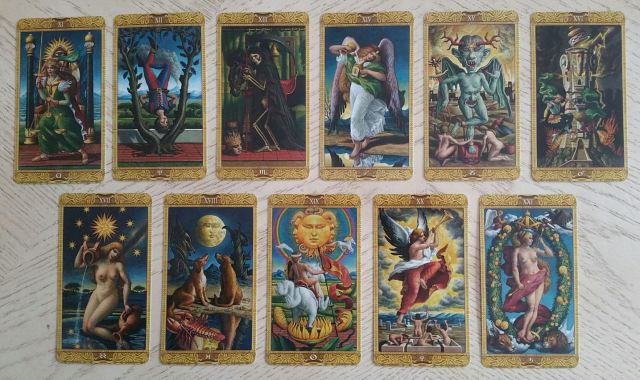





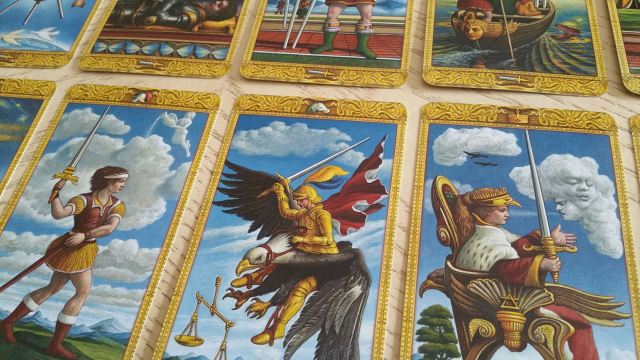
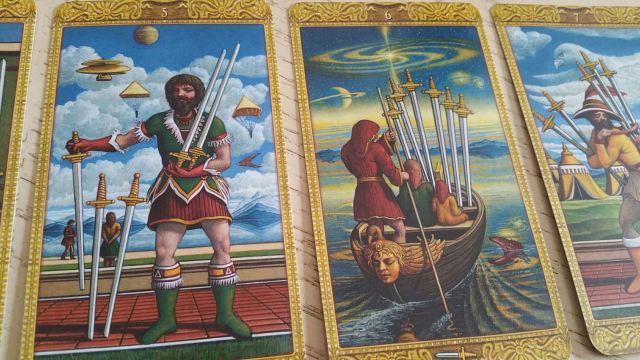
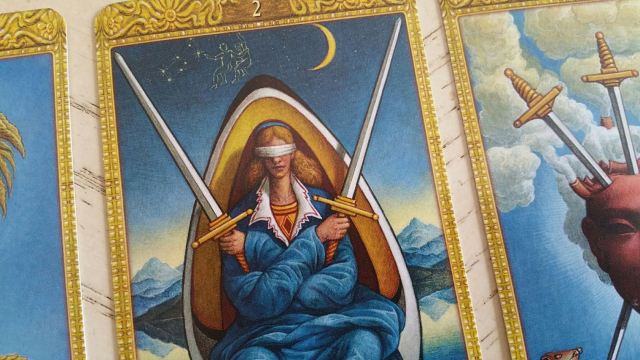

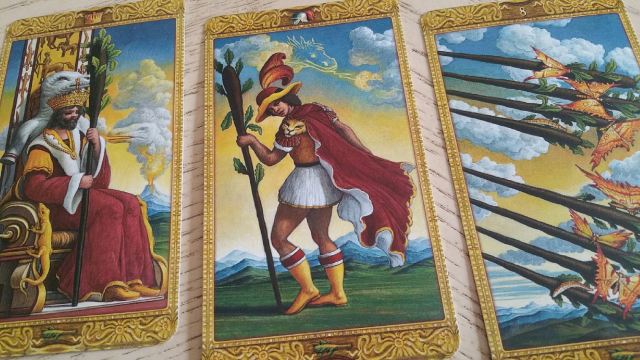
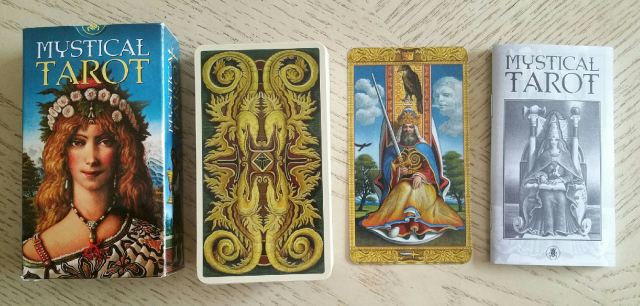
The Artwork really draws you in!
LikeLike
Thank you for the incisive overview of this attractive deck although I question the redefinition of the Three of Swords as the image of Swords piercing the head distorts the meaning of the card. Three is a number of multiplication – the Swords, representing the mind, have grown powerful enough to slay the heart – this is the source of the pain and why its magical title is The Lord of Sorrow.
LikeLike
Pingback: The Mystical Tarot by Giuliano Costa | ravenhawks' magazine
I recently saw the Ace of Swords from this deck online somewhere, and KNEW there must be a deep and magical deck attached to it — I had to find out the name of the deck! Then I got busy and forgot about the whole thing (besides receiving two new decks in the mail yesterday to keep me busy). Seeing your review and the photos of the cards has been like discovering gold in them thar hills! Thank you! This California gal is stoked!
LikeLike
I need this! I just want to dive right into those images. Thank you Benebell.
LikeLike
Oh, and regarding the Three of Swords – that’s exactly how I interpret it. Swords being about ‘headstuff’ and all. I never bought into the pierced heart interpretation – that’s illustrated in the Five of Cups. The Three of Swords, for me, is about mixed up communication, arguments, harsh and hurtful words, and not forgetting events like visits to the dentist.
LikeLike
What a great review, as always. So funny about the shrimp! I see what you mean.
LikeLike
What do you make of the Queen of Pentacles?
LikeLike